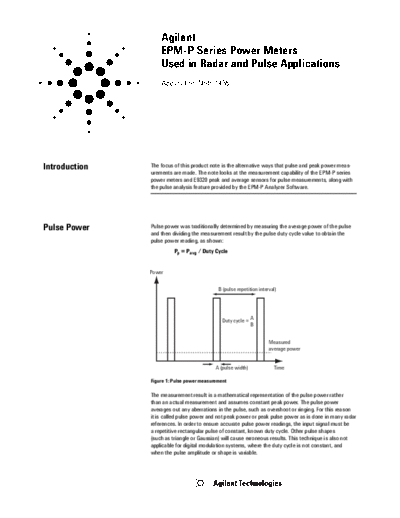Service Manuals, User Guides, Schematic Diagrams or docs for : HP Publikacje 5988-8522EN
<< Back | HomeMost service manuals and schematics are PDF files, so You will need Adobre Acrobat Reader to view : Acrobat Download Some of the files are DjVu format. Readers and resources available here : DjVu Resources
For the compressed files, most common are zip and rar. Please, extract files with Your favorite compression software ( WinZip, WinRAR ... ) before viewing. If a document has multiple parts, You should download all, before extracting.
Good luck. Repair on Your own risk. Make sure You know what You are doing.
Image preview - the first page of the document

>> Download 5988-8522EN documenatation <<
Text preview - extract from the document
Agilent
EPM-P Series Power Meters
Used in Radar and Pulse Applications
Application Note 1438
Introduction The focus of this product note is the alternative ways that pulse and peak power meas-
urements are made. The note looks at the measurement capability of the EPM-P series
power meters and E9320 peak and average sensors for pulse measurements, along with
the pulse analysis feature provided by the EPM-P Analyzer Software.
Pulse Power Pulse power was traditionally determined by measuring the average power of the pulse
and then dividing the measurement result by the pulse duty cycle value to obtain the
pulse power reading, as shown:
Pp = Pavg / Duty Cycle
Power
B (pulse repetition interval)
Duty cycle = A
B
Measured
average power
A (pulse width) Time
Figure 1: Pulse power measurement
The measurement result is a mathematical representation of the pulse power rather
than an actual measurement and assumes constant peak power. The pulse power
averages out any aberrations in the pulse, such as overshoot or ringing. For this reason
it is called pulse power and not peak power or peak pulse power as is done in many radar
references. In order to ensure accurate pulse power readings, the input signal must be
a repetitive rectangular pulse of constant, known duty cycle. Other pulse shapes
(such as triangle or Gaussian) will cause erroneous results. This technique is also not
applicable for digital modulation systems, where the duty cycle is not constant, and
when the pulse amplitude or shape is variable.
There are some advantages with using duty cycle to calculate the pulse power. The duty
cycle technique provides the lowest cost solution, with average power meters and sensors
being less expensive than peak and average power meters and sensors. They also have
the ability to measure over a wide power and frequency range. Agilent 8480 and E9300
average power sensors have a power range ◦ Jabse Service Manual Search 2024 ◦ Jabse Pravopis ◦ onTap.bg ◦ Other service manual resources online : Fixya ◦ eServiceinfo